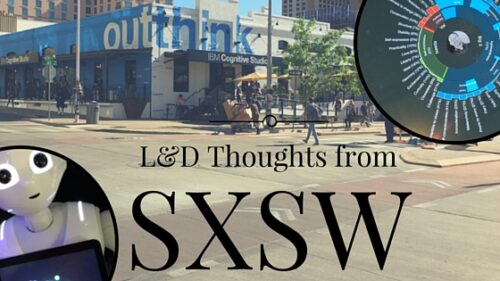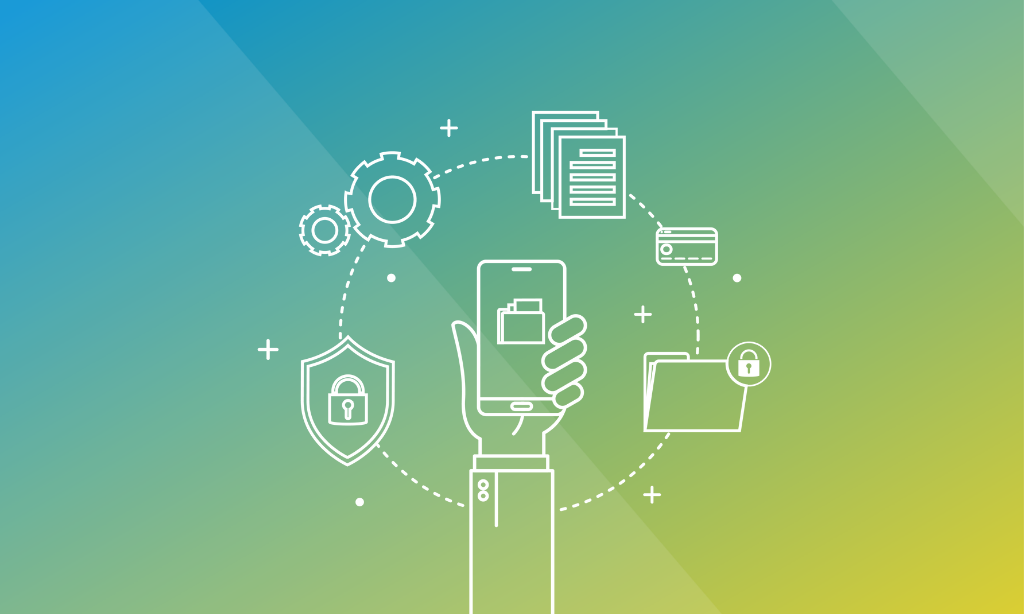The SXSW Interactive Experience with L&D Perspective
SXSW Interactive is a massive event. Even writing that statement doesn’t feel like I’m doing justice to the size of the event. Most events that I attend are confined to one location, like a hotel conference center or complete convention center. But SXSW is large enough to take over a convention center, an events center, and several hotel conference centers…and just about every available open space in between.
The Corporate Houses of Downtown Austin
The entire downtown of Austin Texas is completely taken over by “houses”. A house is a building or area completely designed, sponsored, and some times built, by one company. The space is fully re-branded with the company logo and is filled with demoes, mini stages for presentations, food trucks, and/or full bars. As an example, on my first evening Gina Minks took me to the Dell house. We got there just in time to see the end of a session led by the leaders of Dell labs. Dell had a focus on VR to show off the strength of Dell computer systems driving the VR experiences. I tried to visit as many houses as I could but I’m certain I missed a few. I spent some time at the Mashable house, the IBM house, and the Samsung house. All showing off products, and new cutting edge tech.
The Dell House and The Lonely Whale VR Experience
After attending both CES and SXSW this year, I can honestly say that VR is the next big thing in learning experiences. At the Dell house I had the opportunity to experience VR as a learning experience. Dell’s and it’s Social Good Advocate, Adrien Grenier, partnered to create quite an amazing experience. The VR experience for the Lonely Whale project included active seating that moved and reacted to the VR movie. So not only did you get the visual experience but you also had the sensation of tipping forward and back and feeling bursts of air at just the right moments. It was quite a compelling experience. Watch this short youtube video to get an idea of what it takes to create a learning experience like The Lonely Whale.
I don’t expect to see fully activated seating in training rooms any time soon, but that element of the experience was just an added bonus feature. The reality is that VR is now inexpensive enough to become a legitimate technology based learning solution. I see the VR learning experiences of today as being where computer-based training was in the late 80’s. The technology of learning in the 80’s was just beginning to handle multi-media. Producing CBT was time consuming, costly, and difficult to prove ROI for corporate training purposes. But today we are able to create eLearning courses fast and cheap with more features, and capabilities than learners even need. VR is going through the same cycle with regards to the L&D industry. I predict in 5 years we will have at least one authoring tool available for instructional designers to quickly and easily produce VR learning solutions.
The Qualcomm Augmented Reality Experience
AR (augmented reality) is growing as fast as VR, but just not getting as much press. Qualcomm built a small museum based on AR technology within the Mashable House. The idea is that you can supplement a real world experience with a layered virtual experience on top. This is possible using mobile devices with cameras. The system recognizes an object or structure and triggers the digital layer of information to be viewed on top of the real world image being shown on the screen.
The IBM Cognitive Studio House
The IBM Cognitive Studio was filled demos showing off Watson. It’s hard to explain Watson, and how it may or may not impact our industry. But I will say that without a doubt it will have a significant impact. The IBM Studio experience started with a questionnaire so that Watson could learn a little bit about you. That information was coded into a wrist band. As you walked through the studio you could wave your wrist band at an exhibit and you would get a customized experience. They even had a bar that would create a customized drink for you based on certain preferences identified in the questionnaire. You could play Rock, Paper, Scissors against a robot or have Watson analyze your personality based on your twitter feed.
But my favorite part of the IBM Cognitive Studio was interacting with a robot named Pepper.
While talking to the IBM engineer about Pepper I could see that she was “listening”. It’s head was turned slightly with it’s big eyes watching us as we talked. Then Pepper asked me for a fist bump. On my first try I only tapped it’s robot knuckles and nothing happened. The engineer explained that it was okay to fist bump Pepper as hard as you might fist bump with a human. So I did and Pepper responded by blowing it up. It made me laugh and so it asked if I wanted to fist bump again. That’s the one I recorded above.
Pepper is obviously a robot, and obviously not human. And that’s what made it so strange to actually feel a personal connection with Pepper. The engineer spoke to Pepper as if it were a living thing and so it just felt like it was part of our conversation. And after the fist bump, things got weird. After talking with the engineer for a few more minutes Pepper said, “You look like you could use a hug”. The engineer said, “go ahead and give Pepper a hug.” And so I did. And it was strangely comforting. Pepper could nuzzle her head into your neck and shoulder and wrap her arms around you. I gotta be honest. I enjoyed the robot hug.
Capture the Data of Experience
Representing the L&D community at SXSW was Craig Wiggins and Margaret Roth presenting a session on xAPI. They also presented their session at SXSWedu, and I was told it was well received. It was fun to hang out with Craig at the event and learn more about xAPI and how it’s currently being used.
Here’s my take on xAPI. As far as I can tell, the biggest roadblock to an xAPI implementation is getting access to non-learning systems to insert the code for generating xAPI statements. I mean, some training departments still struggle with getting access to basic IT resources. So, figuring out how to request coding updates to critical business systems may prove challenging for many. And building an LRS is relatively simple as far as I understand it. But building a system to parse all the data and make it meaningful is harder.
I feel like much wider adoption of xAPI needs a kickstart by a big enterprise. Its probably going to take a large software developer like Microsoft, Apple, IBM, or Salesforce.com, or another. And this is only supporting the learning experiences within software. xAPI can and should be collecting other data as well. Specifically data from the internet of things. But basically from any device, or software, that currently collects data about performance in some way or another. It’s obvious that xAPI is building momentum within our industry, but widespread adoption still is a ways off. But maybe not as far off as we might think.
There is a lot more to SXSW than what I can reflect on in a blog post. SXSW Interactive is a non-learning community event filled with excellent learning experiences for everyone interested in technology. And everyone should be interested in technology. I would highly encourage my colleagues to attend at some point in their careers.





